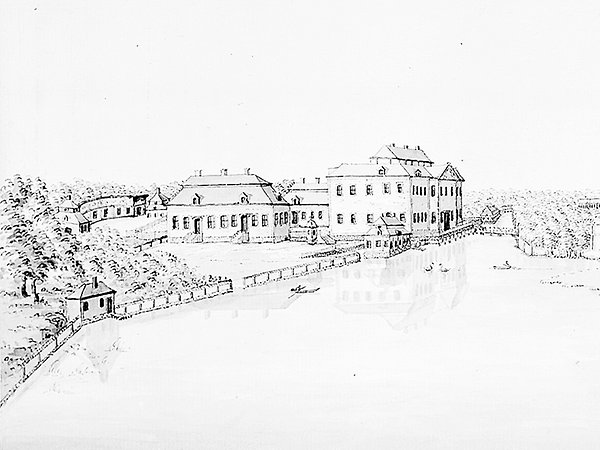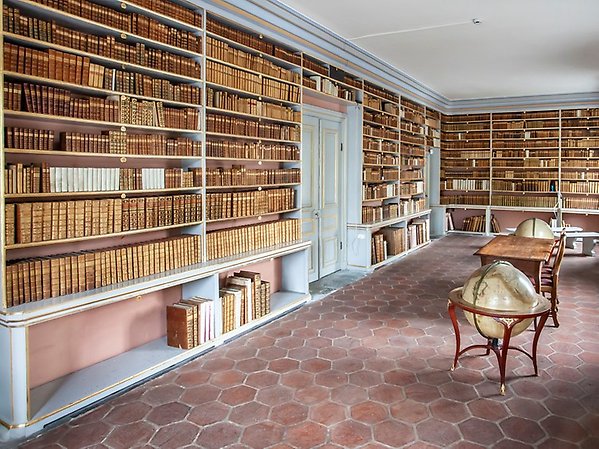The Leufsta Library

View of the castle with the pond, detail from inkwash by Olof von Dalin 1745. From: The picture collection of Jernkontoret.
The Library building
Two wings with manorial roofs were constructed next to the manor house by the pond as early as the 1730s, intended to keep the library and the natural cabinet. Charles De Geer the entomologist (1720–1778) demolished these in 1757 and replaced them with the pavilions that we see there today, which were designed by court architect Jean Eric Rehn and built 1757–1758. The interior was also made by Jean Eric Rehn and has been kept until today, although some minor changes have been made through the centuries. The new library and natural cabinet were finished in 1762 at the latest.
The book collection

Interiör Leufstabiblioteket
Charles the entomologist, who is the most important character in the history of this library, started his book collecting early in his home town of Utrecht, which abounded with bookshops and publishers. He also made frequent visits to Amsterdam, the Hague and Leiden, all of which were of great importance for the European book trade of the time.
Journals like Gazette de Leyde and Leidse Courant were Charles's most important source of information. By reading the advertisements he learnt about recently published literature and forthcoming book auctions, the catalogues of which were published in the journals. Charles continued subscribing to these when he had started running Leufstabruk in 1741. Other important sources of information for him were periodical publications such as the Journal des savants and Philosophical transactions, which are considered to be two of the first modern scholarly journals.
In Sweden, Charles bought some of his foreign literature from the German bookseller Gottfried Kiesewetter in Stockholm, who had a privilege to import books.
From the Swedish scholar Olof Rudbeck the Younger Charles had the opportunity of acquiring the big hand-drawn and hand-coloured illustrated works Blomboken [The Flower Book] and Fogelboken [The Bird Book], as well as the two published volumes of Campus Elysii. Allegedly, Carl Linnaeus said about Fogelboken that "it appears not to be the work of a human hand".
At the auction following the death of Rudbeck the Younger, Charles bought books from his book collection, some of which had been previously owned by the father, Rudbeck the Elder. Among these books was Rudbeck the Younger's book of sketches Iter Lapponicum - A Journey to Lappland. On the same occasion De Geer also purchased Basilius Besler's Hortus Eystettensis printed in Nürnberg in 1613 in two volumes, one of which is coloured. He also bought four manuscripts written by the young Carl Linnaeus including Catalogus plantarum rariorum Scaniae dated 1728 and Adonis sive Hortus Uplandicus dated 1731. In the latter Linnaeus classifies plants in Uppsala's botanical gardens according to his new sexual system.
- Books bought at the auction following the death of Rudbeck the Younger
- Books bought at the auction following the death of Rudbeck the Younger in digital copies
In addition to entomology, general zoology and botany, there is also ichthyology, the scientific study of fishes, in Charles De Geer's book collection. One splendid example is Louis Renard's beautiful book with hand-coloured plates from 1754 about fishes and crustaceans in the sea surrounding the Islands of the Moluccas.
When Charles the entomologist had passed away in 1778 his sons soon cancelled all the subscriptions of periodicals. During the time of Charles de De Geer the politician (1746–1805) at Leufstabruk the acquisitions of books to the library are fewer and of another kind. Entertainment and political literature becomes more common, forbidden books included.
The library also holds a large number of books that has belonged to Hedvig Ulrika De Geer (1752–1813), daughter of Charles the entomologist, and sister of Charles the politician. They arrived at Leufstabruk after her death.
Uppsala University Library's acquisition of the approximately 10.000 titles was made possible by public grants and two large private donations. The book collection is listed in a catalogue compiled by E.G. Lilljebjörn. The printed books are catalogued in the national union catalogue Libris. Several copies in the collection have been fully digitised, and are available for free in Alvin.
- Printed works at the Leufsta Library in Libris
- Digitised works at the Leufsta Library in Alvin
- Printed works at Carolina Rediviva, in Libris
The project The Library of Leufstabruk
The Library of Leufstabruk was a collaborative project between Uppsala University Library and the Koninklijke Bibliotheek, National Library of the Netherlands, during 2018–2020. Riksbankens Jubileumsfond (RJ) granted means to the project, in order to make the book collection of the library much more accessible for research. Participants in the project were project manager Peter Sjökvist, Helena Backman and Alex Alsemgeest.
The project registered all books in modern databases (Libris, Alvin) and connected these with the Dutch Short-Title Catalogue, Netherlands (STCN). A detailed register of provenances and copy-specific information in cases of special interest, for example a selection of bookbindings in Alvin. Archival materials concerning the library including correspondence with the Dutch booksellers Luchtmans have also been digitised. A full digitisation of copies from previously unattested Dutch editions has been made. By these measures, the access to and knowledge of the highly international material at the library of Leufstabruk and its history has been greatly improved for researchers nationally and internationally.

